SNVS334F January 2005 – January 2016 LM2734Z , LM2734Z-Q1
PRODUCTION DATA.
- 1 Features
- 2 Applications
- 3 Description
- 4 Revision History
- 5 Pin Configuration and Functions
- 6 Specifications
- 7 Detailed Description
-
8 Application and Implementation
- 8.1 Application Information
- 8.2
Typical Applications
- 8.2.1
LM2734Z Design Example 1
- 8.2.1.1 Design Requirements
- 8.2.1.2
Detailed Design Procedure
- 8.2.1.2.1 Inductor Selection
- 8.2.1.2.2 Input Capacitor
- 8.2.1.2.3 Output Capacitor
- 8.2.1.2.4 Catch Diode
- 8.2.1.2.5 Boost Diode
- 8.2.1.2.6 Boost Capacitor
- 8.2.1.2.7 Output Voltage
- 8.2.1.2.8 Calculating Efficiency, and Junction Temperature
- 8.2.1.2.9 Calculating the LM2734Z Junction Temperature
- 8.2.1.2.10 WSON Package
- 8.2.1.2.11 Package Selection
- 8.2.1.3 Application Curve
- 8.2.2 LM2734Z Design Example 2
- 8.2.3 LM2734Z Design Example 3
- 8.2.4 LM2734Z Design Example 4
- 8.2.5 LM2734Z Design Example 5
- 8.2.1
LM2734Z Design Example 1
- 9 Power Supply Recommendations
- 10Layout
- 11Device and Documentation Support
- 12Mechanical, Packaging, and Orderable Information
7 Detailed Description
7.1 Overview
The LM2734Z is a constant frequency buck regulator that can deliver load current of 1 A. Device is optimized for high-efficiency operation and includes a number of features that make it suitable for demanding applications. High switching frequency allows for use of small external components enabling small solution size and saving board space.
Device is designed to operate from wide input voltage range up to 20 V, making it ideal for wide range of applications (such as automotive, industrial, communications, and so forth). LM2734Z can be controlled through shutdown pin, consuming only 30 nA in standby mode, making it very appealing for applications that demand very low standby power consumption.
7.2 Functional Block Diagram
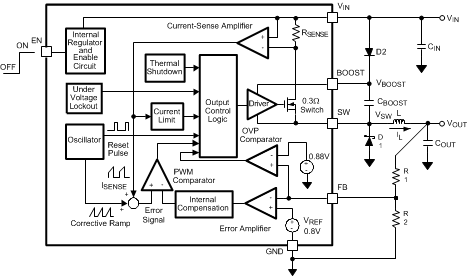
7.3 Feature Description
7.3.1 Theory of Operation
The LM2734Z is a constant frequency PWM buck regulator IC that delivers a 1-A load current. The regulator has a preset switching frequency of 3 MHz. This high frequency allows the LM2734Z to operate with small surface mount capacitors and inductors, resulting in a DC–DC converter that requires a minimum amount of board space. The LM2734Z is internally compensated, so it is simple to use, and requires few external components. The LM2734Z uses current-mode control to regulate the output voltage.
The following operating description of the LM2734Z refers to the Functional Block Diagram and to the waveforms in Figure 7. The LM2734Z supplies a regulated output voltage by switching the internal NMOS control switch at constant frequency and variable duty cycle. A switching cycle begins at the falling edge of the reset pulse generated by the internal oscillator. When this pulse goes low, the output control logic turns on the internal NMOS control switch. During this ON-time, the SW pin voltage (VSW) swings up to approximately VIN, and the inductor current (IL) increases with a linear slope. IL is measured by the current-sense amplifier, which generates an output proportional to the switch current. The sense signal is summed with the corrective ramp of the regulator and compared to the output of the error amplifier, which is proportional to the difference between the feedback voltage and VREF. When the PWM comparator output goes high, the output switch turns off until the next switching cycle begins. During the switch OFF-time, inductor current discharges through Schottky diode D1, which forces the SW pin to swing below ground by the forward voltage (VD) of the catch diode. The regulator loop adjusts the duty cycle (D) to maintain a constant output voltage.
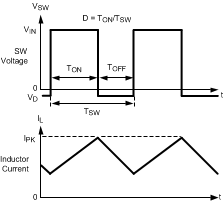 Figure 7. LM2734Z Waveforms of SW Pin Voltage and Inductor Current
Figure 7. LM2734Z Waveforms of SW Pin Voltage and Inductor Current
7.3.2 Boost Function
Capacitor CBOOST and diode D2 in Figure 8 are used to generate a voltage VBOOST. VBOOST - VSW is the gate drive voltage to the internal NMOS control switch. To properly drive the internal NMOS switch during its ON-time, VBOOST needs to be at least 1.6 V greater than VSW. Although the LM2734Z operates with this minimum voltage, it may not have sufficient gate drive to supply large values of output current. Therefore, TI recommends that VBOOST be greater than 2.5 V above VSW for best efficiency. VBOOST – VSW must not exceed the maximum operating limit of 5.5 V.
5.5 V > VBOOST – VSW > 2.5 V for best performance.
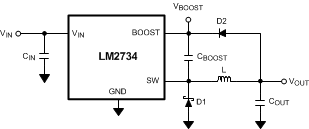 Figure 8. VOUT Charges CBOOST
Figure 8. VOUT Charges CBOOST
When the LM2734Z starts up, internal circuitry from the BOOST pin supplies a maximum of 20 mA to CBOOST. This current charges CBOOST to a voltage sufficient to turn the switch on. The BOOST pin continues to source current to CBOOST until the voltage at the feedback pin is greater than 0.76 V.
There are various methods to derive VBOOST:
- From the input voltage (VIN)
- From the output voltage (VOUT)
- From an external distributed voltage rail (VEXT)
- From a shunt or series zener diode
In Functional Block Diagram, capacitor CBOOST and diode D2 supply the gate-drive current for the NMOS switch. Capacitor CBOOST is charged through diode D2 by VIN. During a normal switching cycle, when the internal NMOS control switch is off (TOFF) (refer to Figure 7), VBOOST equals VIN minus the forward voltage of D2 (VFD2), during which the current in the inductor (L) forward biases the Schottky diode D1 (VFD1). Therefore the voltage stored across CBOOST is calculated using Equation 1.
When the NMOS switch turns on (TON), the switch pin rises to:
forcing VBOOST to rise thus reverse biasing D2. The voltage at VBOOST is then:
which is approximately:
for many applications. Thus the gate-drive voltage of the NMOS switch is approximately:
An alternate method for charging CBOOST is to connect D2 to the output as shown in Figure 8. The output voltage must be between 2.5 V and 5.5 V, so that proper gate voltage is applied to the internal switch. In this circuit, CBOOST provides a gate drive voltage that is slightly less than VOUT.
In applications where both VIN and VOUT are greater than 5.5 V, or less than 3 V, CBOOST cannot be charged directly from these voltages. If VIN and VOUT are greater than 5.5 V, CBOOST can be charged from VIN or VOUT minus a Zener voltage by placing a Zener diode D3 in series with D2, as shown in Figure 9. When using a series Zener diode from the input, ensure that the regulation of the input supply does not create a voltage that falls outside the recommended VBOOST voltage.
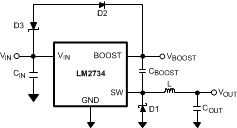 Figure 9. Zener Reduces Boost Voltage from VIN
Figure 9. Zener Reduces Boost Voltage from VIN
An alternative method is to place the Zener diode D3 in a shunt configuration as shown in Figure 10. A small 350-mW to 500-mW, 5.1-V Zener in a SOT or SOD package can be used for this purpose. A small ceramic capacitor such as a 6.3-V, 0.1-µF capacitor (C4) must be placed in parallel with the Zener diode. When the internal NMOS switch turns on, a pulse of current is drawn to charge the internal NMOS gate capacitance. The 0.1-µF parallel shunt capacitor ensures that the VBOOST voltage is maintained during this time.
Resistor R3 must be chosen to provide enough RMS current to the Zener diode (D3) and to the BOOST pin. A recommended choice for the Zener current (IZENER) is 1 mA. The current IBOOST into the BOOST pin supplies the gate current of the NMOS control switch and varies typically according to Equation 8.
where
- D is the duty cycle
- VZENER and VD2 are in volts
- IBOOST is in milliamps
- VZENER is the voltage applied to the anode of the boost diode (D2)
- VD2 is the average forward voltage across D2
NOTE
Equation 8 for IBOOST gives typical current.
For the worst case IBOOST, increase the current by 25%. In that case, the worse-case boost current is:
R3 is then given by Equation 10.
For example, let VIN = 10 V, VZENER = 5 V, VD2 = 0.7 V, IZENER = 1 mA, and duty cycle D = 50%. Then:
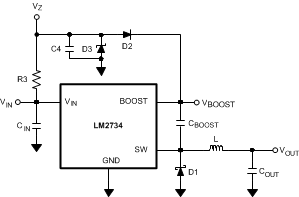 Figure 10. Boost Voltage Supplied from the Shunt Zener on VIN
Figure 10. Boost Voltage Supplied from the Shunt Zener on VIN
7.3.3 Soft-Start
This function forces VOUT to increase at a controlled rate during start-up. During soft-start, the reference voltage of the error amplifier ramps from 0 V to its nominal value of 0.8 V in approximately 200 µs. This forces the regulator output to ramp up in a more linear and controlled fashion, which helps reduce inrush current.
7.3.4 Output Overvoltage Protection
The overvoltage comparator compares the FB pin voltage to a voltage that is 10% higher than the internal reference Vref. Once the FB pin voltage goes 10% above the internal reference, the internal NMOS control switch is turned off, which allows the output voltage to decrease toward regulation.
7.3.5 Undervoltage Lockout
Undervoltage lockout (UVLO) prevents the LM2734Z from operating until the input voltage exceeds 2.74 V (typical).
The UVLO threshold has approximately 440 mV of hysteresis, so the part operates until VIN drops below 2.3 V (typical). Hysteresis prevents the part from turning off during power up if VIN is non-monotonic.
7.3.6 Current Limit
The LM2734Z uses cycle-by-cycle current limiting to protect the output switch. During each switching cycle, a current limit comparator detects if the output switch current exceeds 1.7 A (typical), and turns off the switch until the next switching cycle begins.
7.4 Device Functional Modes
7.4.1 Enable Pin and Shutdown Mode
The LM2734Z has a shutdown mode that is controlled by the enable pin (EN). When a logic low voltage is applied to EN, the part is in shutdown mode and its quiescent current drops to typically 30 nA. Switch leakage adds another 40 nA from the input supply. The voltage at this pin must never exceed VIN + 0.3 V.
7.4.2 Thermal Shutdown
Thermal shutdown limits total power dissipation by turning off the output switch when the IC junction temperature exceeds 165°C. After thermal shutdown occurs, the output switch doesn’t turn on until the junction temperature drops to approximately 150°C.